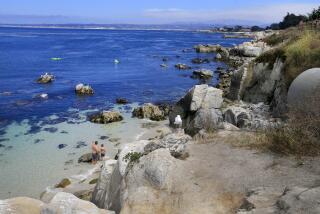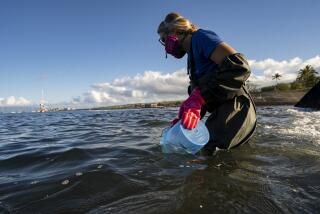Scientist Seeks Clues to Death of Florida Coral
- Share via
ABOARD THE R/V SEWARD JOHNSON — Sandra Brooke sits in the cockpit of the four-seat submarine, eager to be hoisted into the ocean for a trip to see her “babies.”
The scientist’s life work is the resurrection of a unique bank of deep-water ivory tree coral off Florida’s east coast, and only now is she about to see it in person for the first time.
The reefs, hundreds of feet deep along a stretch of 120 miles from Fort Pierce to Daytona Beach, are home to more than 70 types of fish. Giant sunfish and squid have come to the deep reefs, and 6-foot roughtail stingrays have mated there.
The reefs once provided a critical habitat for commercially important fish, such as snowy grouper, gag and scamp. But overfishing in the 1970s and 1980s decimated the fish population, and now there are vast areas of dead coral rubble.
“It looks like someone has systematically gone through there with a bulldozer,” said Brooke, a native of Nottinghamshire, England, who is doing doctoral studies on the reef through the Harbor Branch Oceanographic Institution. “Coral’s so fragile, you can smash it with your fingers.”
Scientists aren’t sure what caused the coral to die. It could be the fault of fishermen using large nets dragged across the ocean floor. Or it could be part of a natural process, including erosion and periodic die-off.
While much research has been done on shallow-water reefs, visible with scuba gear or even just a mask and snorkel, little is known about these banks of coral about 16 to 20 miles off the Atlantic coast on the edge of the continental shelf.
The reefs are rare. They are the only ones in the United States made up of just one species of coral, ivory tree coral, or Oculina, according to John Reed, senior research specialist at Harbor Branch who has studied their diverse animal life.
In 1982, a 92-square-mile section of the reefs was designated by the government as an area of particular concern. Bottom fishing has been banned in the area until 2004 to allow investigations into the recovery of the fish populations.
Brooke’s research, funded by a $65,000 annual federal grant for two years, is focused specifically on the reproduction of the coral itself. Her work links closely with that of Chris Koenig, a research biologist with the Institute for Fisheries Resource Ecology, a joint effort of Florida State University and the National Marine Fisheries Service.
“If you want to know how to rebuild a habitat, you’ve got to know how they reproduce,” Koenig said. “From our point of view, we want our cake and [to] eat it too: We want a habitat for the fish now, and we want to rebuild the Oculina that were there before.”
In late June, Brooke and a team of scientists boarded the research vessel Seward Johnson for a daylong mission to transplant pieces of coral for a six-month test on reproduction and to pick up 10 samples along the way. She had never been to the hidden bank of coral, though she’d worked with samples recovered by other researchers.
“They’re my babies,” she said before the submersible launched from the Seward Johnson traveled to the reefs 250 feet below the surface. The craft can pick up and drop off samples using mechanical arms controlled from the 6-foot Plexiglas sphere that makes up the cockpit.
The ivory tree coral has pinnacles, mounts and ridges that can stretch up to 80 feet from the ocean floor and hundreds of feet wide. It grows in massive thickets and spherical colonies, providing homes for thousands of creatures that are food for larger fish.
A single basketball-size coral head may provide refuge to more than 2,000 animals, according to Reed.
In hopes of rejuvenating the fish population, Koenig has placed 56 giant cement blocks along the ocean floor to act as a substitute for the coral while the real coral recovers.
But growth does not happen quickly. The coral is estimated to grow only a half-inch per year. So a colony of coral 5 feet in diameter likely took 120 years to grow.
In Brooke’s experiment, seeking knowledge about growth and reproduction, she attached samples of the coral to small cement blocks, which were placed around the reefs. They’ll be recovered six months later to examine growth and for further testing.
Brooke’s first trip to the reefs was a challenge. While the ocean’s surface was smooth as glass and visibility stretched for miles, the crew in the submarine could barely see 8 feet because the ocean floor was churned up by the Gulf Stream. On a good day, visibility can be up to 30 feet.
The poor visibility made it tough to navigate the area where few researchers have traveled.
“We’ve got much better maps of Mars than we do of the bottom of the ocean,” said Dan Boggess, a sub pilot and lead electronic technician who worked in the radio room on this mission.
Brooke and her crew did stumble upon some good news: Dime-sized evidence on one of Koenig’s cement blocks showing the coral was successfully reproducing, a process known as recruitment.
Still, it will take decades if not centuries for the coral to be restored. Even then, other man-made and natural perils could interfere.
“It may be that if we leave it alone, it will do it itself,” Brooke said. “We’re just trying to give it a helping hand.”
More to Read
Sign up for Essential California
The most important California stories and recommendations in your inbox every morning.
You may occasionally receive promotional content from the Los Angeles Times.













